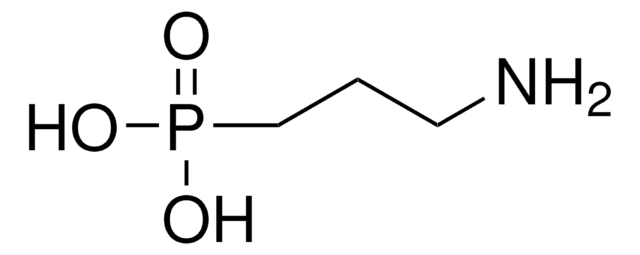Wszystkie zdjęcia(2)
Key Documents
777161
11-Hydroxyundecylphosphonic acid
≥95% (GC)
Synonim(y):
P-(11-Hydroxyundecyl)phosphonic acid
Zaloguj sięWyświetlanie cen organizacyjnych i kontraktowych
About This Item
Wzór empiryczny (zapis Hilla):
C11H25O4P
Numer CAS:
Masa cząsteczkowa:
252.29
Numer MDL:
Kod UNSPSC:
12352103
Identyfikator substancji w PubChem:
NACRES:
NA.23
Polecane produkty
Poziom jakości
Próba
≥95% (GC)
Postać
powder
mp
107-111 °C
ciąg SMILES
OCCCCCCCCCCCP(O)(O)=O
InChI
1S/C11H25O4P/c12-10-8-6-4-2-1-3-5-7-9-11-16(13,14)15/h12H,1-11H2,(H2,13,14,15)
Klucz InChI
PPCDEFQVKBXBPS-UHFFFAOYSA-N
Opis ogólny
11-Hydroxyundecylphosphonic acid (HUPA) is an alkyl phosphonic acid that forms a self-assembled monolayer (SAM) on a variety of metal oxides and metal surfaces. It forms a hydroxyl terminated SAM that provides a physiological stability and controls the surface density of the coating.
Zastosowanie
An organophosphonate surface modifier for label-free and low-cost biosensing applications;
Organophosphonic acid self-assembled monolayers (SAMs);
A hydroxyalkylphosphonate monolayer used to covalently bind primary amine groups in protein domains using chloroformate-derived crosslinking
Organophosphonic acid self-assembled monolayers (SAMs);
A hydroxyalkylphosphonate monolayer used to covalently bind primary amine groups in protein domains using chloroformate-derived crosslinking
HUPA is mainly used as a spacer/linker that forms a SAM on titanium oxide (TiO2) surfaces to immobilize the surface atoms for the formation of biocompatible materials for biomedical applications. It can also be used to functionalize the silicon-photonic resonators for biosensing applications.
This page may contain text that has been machine translated.
Hasło ostrzegawcze
Warning
Zwroty wskazujące rodzaj zagrożenia
Zwroty wskazujące środki ostrożności
Klasyfikacja zagrożeń
Eye Irrit. 2 - Skin Irrit. 2 - STOT SE 3
Organy docelowe
Respiratory system
Kod klasy składowania
11 - Combustible Solids
Klasa zagrożenia wodnego (WGK)
WGK 3
Temperatura zapłonu (°F)
Not applicable
Temperatura zapłonu (°C)
Not applicable
Wybierz jedną z najnowszych wersji:
Masz już ten produkt?
Dokumenty związane z niedawno zakupionymi produktami zostały zamieszczone w Bibliotece dokumentów.
Klienci oglądali również te produkty
Crystalline TiO2 grafted with poly (2-methacryloyloxyethyl phosphorylcholine) via surface-initiated atom-transfer radical polymerization
Zhao Y, et al.
Applied Surface Science, 257(5), 1596-1601 (2010)
Copper oxide surfaces modified by alkylphosphonic acids with terminal pyridyl-based ligands as a platform for supported catalysis
Andrews B, et al.
Polyhedron, 114, 360-369 (2016)
Chunyi Chiang et al.
Langmuir : the ACS journal of surfaces and colloids, 28(1), 548-556 (2011-11-23)
We report a robust strategy for conjugating mixtures of two or more protein domains to nonfouling polyurethane surfaces. In our strategy, the carbamate groups of polyurethane are reacted with zirconium alkoxide from the vapor phase to give a surface-bound oxide
Covalent functionalization of TiO2 nanotube arrays with EGF and BMP-2 for modified behavior towards mesenchymal stem cells
Bauer S, et al.
Integrative Biology : Quantitative Biosciences from Nano to Macro, 3(9), 927-936 (2011)
Phosphonic acid monolayers for binding of bioactive molecules to titanium surfaces.
Adden N
Langmuir, 22(19), 8197-8204 (2006)
Nasz zespół naukowców ma doświadczenie we wszystkich obszarach badań, w tym w naukach przyrodniczych, materiałoznawstwie, syntezie chemicznej, chromatografii, analityce i wielu innych dziedzinach.
Skontaktuj się z zespołem ds. pomocy technicznej









